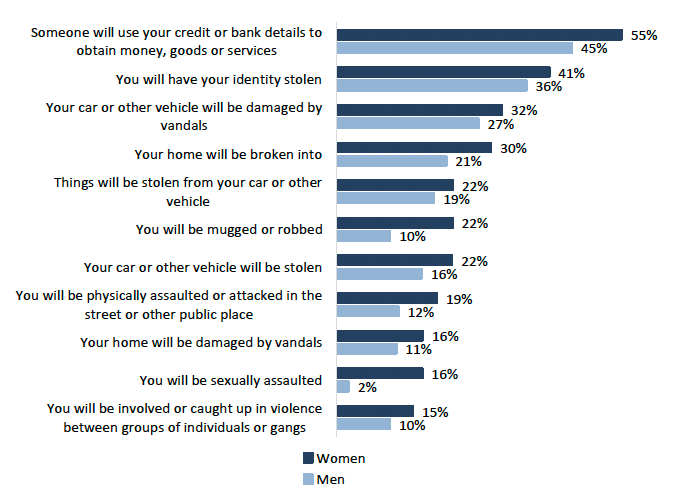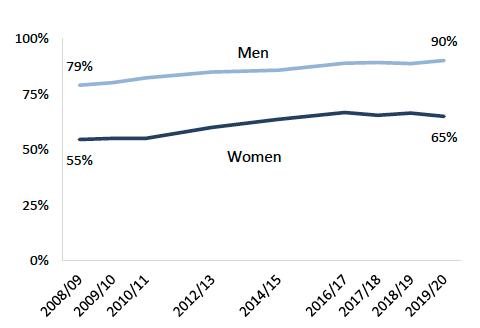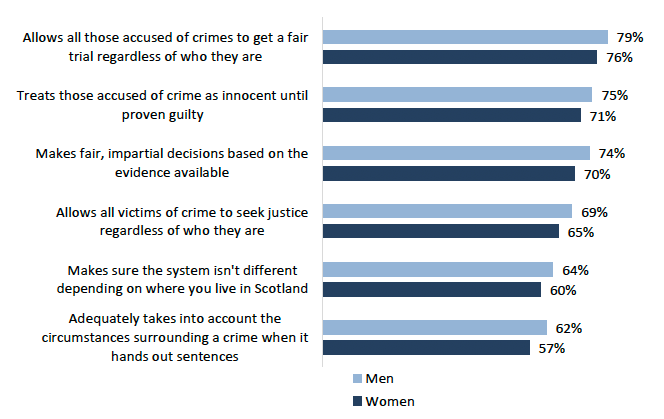Women in the justice system: evidence review
A review of quantitative evidence, drawn from a range of statistical data sources across the justice system in Scotland, comparing findings for women against those for men.
3. Perceptions of crime, safety, the police and the justice system
Key findings:
Women are more likely than men to think crime levels have increased, both locally and nationally.
Women feel less safe than men walking alone after dark or at home alone at night.
Women are more likely than men to be concerned about crime and perceive some issues to be more prevalent in their neighbourhood than men.
There are no difference between men and women in their belief that the police do an 'excellent' or 'good' job, however this proportion has fallen for both groups since 2012-13.
Women are less confident than men on a number of measures asked about in the Scottish Crime and Justice Survey which explore views on the criminal justice system.
This section looks at differences between women and men in perceptions on a series of themes including trends of local and national crime, how safe people feel walking alone or at home alone at night, public confidence in the ability of the police and their attitudes towards the criminal justice system. Some general information on experiences of civil law problems is also provided.
Information presented below is drawn from the Scottish Crime and Justice Survey (SCJS) 2019-20. Some findings from the Scottish Victimisation Telephone Survey (SVTS) 2020 are also provided to show people's perceptions during the COVID-19 pandemic. These results are based on a sample of around 2,700 telephone interviews conducted in September and October 2020.
3.1 Perceptions of crime
In 2019-20, fewer women than men (69% compared to 76%) said that the crime rate in their local area had decreased or stayed the same over the last couple of years. Conversely, women were more likely than men to think that the crime rate in their local area had increased (27% compared to 19%). When combined with age, there was no clear pattern between the groups.
Similarly, views on the national crime rate also varied between women and men. Women were less likely than men to think crime had been stable or fallen across the country as a whole over the last couple of years (39% compared to 52%) and more likely to think crime had increased (51% compared to 39%). When combined with age, men were more likely than women to believe that crime had been stable or fallen across the country over the last couple of years, for all age groups.
Women are more likely than men to be concerned about crime and perceive some issues to be more prevalent in their neighbourhood than men.
Women were more worried than men about experiencing all of the specific crime types which respondents were asked about in the SCJS in 2019-20 (Figure 2). For example:
- more women than men were worried they would be physically assaulted or attacked in the street or other public place (19% compared to 12%)
- more women than men were worried they would be sexually assaulted (16% compared to 2%)

Source: Scottish Crime and Justice Survey 2019-20
Additionally, a greater proportion of women than men thought it was likely that:
- someone would use their bank details to obtain money, goods, or services (25% compared to 21% of men)
- their home would be broken into (8% compared to 6% of men)
- their home would be damaged by vandals (4% compared to 3% of men)
- they would be mugged or robbed (4% compared to 2% of men) and
- that they would be sexually assaulted (3% compared to less than 1% of men)
Fewer differences were found with respect to the perceived prevalence of different types of crime in the local area. For example, there was no difference between the proportion of men and the proportion of women believing people being sexually assaulted to be common in their local area (at 5% overall). However, women were more likely to consider people having their vehicle stolen and violence between groups of individuals or gangs as common issues.
While SVTS and SCJS are not comparable due to a number of differences in the way the two surveys are designed and conducted[18], the SVTS found that women continued to have somewhat more negative perceptions than men of local and national crime rates, during the first six months of the COVID-19 pandemic.
The SVTS found that women were more likely than men to believe that crime had gone up in their local area since the virus outbreak[19] (18% compared to 13%). Conversely, women were less likely to believe that crime had decreased in their local area since the virus outbreak (21% compared to 26%).
Women were also more likely than men to have perceived an increase in crime in Scotland as a whole (25% compared to 17%).
While the results from the SVTS are not directly comparable with earlier runs of the SCJS, both sources suggest women are more likely than men to think crime levels had increased, both locally and nationally. As such, it is difficult to say whether COVID-19 has had any impact on the views of women and men, given there is some evidence to suggest the difference between these groups already existed prior to the pandemic.
3.2 Feelings of safety
While more women in Scotland felt safe walking alone in their local area after dark in 2019/20 than a decade ago, they were still less likely to feel safe than men (65%, compared to 90%, respectively) (Figure 3). Across all age groups, women were less likely than men to feel safe, and more likely to feel unsafe walking alone in their local area after dark.
This is a similar finding to other parts of the UK. For example the Crime Survey for England and Wales also finds that women are less likely to feel safe when walking alone after dark[20].

Source: Scottish Crime and Justice Survey, 2008-09 to 2019-20
The clear majority of women (93%) felt safe in their home alone at night in 2019-20. This is more than a decade ago, however the proportion is still lower than that for men (98%). This difference is not seen when looking at only young people (age 16 to 24), however in every other age group women were less likely to feel safe and more likely to feel unsafe.
Although not directly comparable to SCJS results, the SVTS also found that despite the majority of adults feeling safe walking alone in their local area after dark (75%), there were still some differences between women and men. Women were less likely than men to feel safe (62% and 89%, respectively).
When asked if there had been any difference in how safe they felt walking alone in their local area after dark since the COVID-19 virus outbreak, women were more likely than men to say they felt less safe (9% compared to 4%).
3.3 Perceptions of the police and the criminal justice system
In 2019-20, women were less likely than men to think that the police in their area treat everyone fairly regardless of who they are (61% compared to 65%). When looking at results for women and men by age, this finding is true for older age groups (45 to 59 and 60+), however the younger age groups (16 to 24 and 25 to 44) show no difference, suggesting age could be more of a driving factor.
The views of women and men did however align for all aspects of confidence in the police (e.g. catch criminals, prevent crime etc.), including on the ability of the police to do an 'excellent' or 'good' job (55% overall). This proportion has fallen for both groups since 2012-13, from 62% to 56% for women and from 59% to 54% for men. Although no differences between the views of women and men were found, when combined with age the results showed that younger women (aged 16-24) were more likely than older women (aged 45-60 and 60+) to think the police were doing an 'excellent' or 'good' job. No such difference was found between the age groups for men.
While not directly comparable to these SCJS findings, the SVTS also found no variation between women and men in the likelihood of believing that the police in the local area were doing an 'excellent' or 'good' job. Overall, three-in-five (60%) adults believed so at the time of interview.
The SCJS found that women were less likely to be confident in the justice system than men, with a lower proportion who said they were confident on six of the twelve measures asked about in the SCJS[21] (Figure 4).

Source: Scottish Crime and Justice Survey 2019-20
The level of confidence that everyone has access to the justice system if they need it was adopted as a National Indicator in the Scottish Government's refreshed National Performance Framework in 2018.
In 2019-20, 75% of adults were confident that the Scottish criminal justice system makes sure everyone has access to the system if they need it. There is no difference in the proportion of women and men who think this.
Contact
Email: Justice_Analysts@gov.scot
There is a problem
Thanks for your feedback